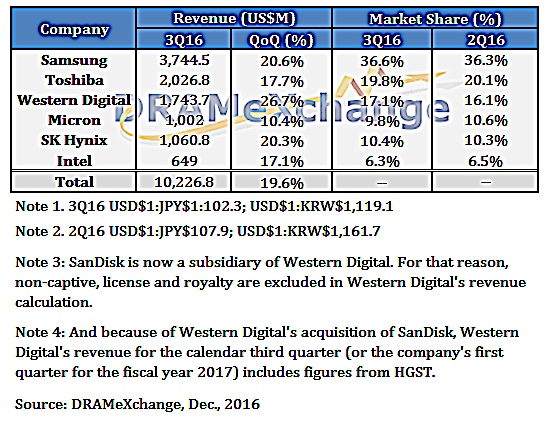Global NAND Flash Revenue Rose 20% Sequentially in 3Q16 – DRAMeXchange
Demand outpaced supply and prices will see larger increases.
This is a Press Release edited by StorageNewsletter.com on December 6, 2016 at 2:50 pm This report was written by Sean Yang, research director, semiconductor and hardware coverage, DRAMeXchange/TrendForce, on December 1, 2016.
This report was written by Sean Yang, research director, semiconductor and hardware coverage, DRAMeXchange/TrendForce, on December 1, 2016.
Prices of NAND flash rose in the third quarter as smartphone makers continued to generate robust demand for related products and the technological transition from 2D-NAND to 3-NAND manufacturing reduced the industry’s overall output.
The report from DRAMeXchange, a division of TrendForce, finds that the revenue of the global NAND flash industry grew 19.6% sequentially in the third quarter.
At the same time, NAND flash suppliers made larger gains in respective their operating margins compared with the prior quarter.
“The NAND flash market outlook for the fourth quarter of 2016 indicates that NAND flash supply will be under greater strain with the advent of the peak shipment season season for end devices,” said Yang. “Therefore, contract prices for various NAND Flash products will see larger increases, which in turn will take suppliers’ revenues and operating margins to new highs for this year.”
Revenue ranking of branded NAND flash suppliers, 3Q16
Samsung
Samsung retained its first place position in the quarterly revenue ranking as the company benefited from strong demand from Chinese smartphone brands for high-capacity eMMC and UFS products. Among the suppliers, the company currently has the largest global market shares for high-capacity eMMC and UFS products. The company is also the leader in the global eMCP market. At the same time, Samsung shipments of enterprise-grade SSDs have expanded as the supplier’s solutions offer better bargain for customers.
Samsung’s third-quarter NAND flash bit shipments increased by 20% compared with the prior quarter. The supplier’s quarterly revenue from NAND Flash sales for the same period advanced about 20% sequentially.
Samsung’s revenue outlook for this fourth quarter is expected to be even better than the third. Demands for eMMC, UFS and eMCP products will be at their annual peaks on account of the seasonal increase in smartphone shipments. Moreover, Samsung will continue to enlarge its market shares for client- and enterprise-grade SSDs.
SK Hynix
During the third quarter, SK Hynix also enjoyed strong demand from Chinese smartphone brands for eMMC and eMCP as well as stock-up activities related to releases of new smartphones. Compared with the second quarter, the firm posted a 12% increase in its NAND flash bit shipments and a 7% increase in the ASP of its NAND flash chips. As a result, SK Hynix’s third-quarter NAND flash revenue rose 20.3% sequentially to around $1.06 billion.
In terms of product planning, the company will be able to boost its 3D-NAND production capacity to around 20,000~30,000 wafers per month before the end of 2016. The supplier will commence shipments of its third-generation 3D-NAND flash in the first quarter of 2017. The supplier’s fourth-generation NAND flash may also be ready for small-batch runs by the second half of next year.
Toshiba
Results from its NAND flash business from July to September (or the company’s fiscal second quarter for 2016) showed that the upturn in the NAND flash market caused the supplier’s bit shipments to grow by 15% compared with the previous three-month period. Moreover, there was a moderation in the decline of the supplier’s NAND flash ASP. On the whole, its NAND flash revenue for its fiscal second quarter rose about 17% sequentially. The supplier also saw increase in its operating margin, reflecting a steady improvement in its NAND Flash business.
With regard to production planning, Toshiba’s newly rebuilt facility Fab 2 at Yokkaichi (in Mie Prefecture, Japan) has been assigned to produce 3D-NAND flash and is expected to achieve a capacity of 40,000 wafers per month during this calendar fourth quarter (October to December 2016). The capacity of Fab 2 will expand again 2017 when the facility is scheduled to begin mass production of its 64-layer 3D-NAND Flash. The company will also begin the construction of a new facility Fab 6 in February of 2017.
Western Digital
The calendar third quarter of 2016 was its first quarter for the company’s fiscal year of 2017. During this period, the supplier focus its investment on 64-layer 3D-NAND flash. The product is now being tested by OEM customers and is expected to be available for memory cards, USB drives and other removable storage devices at the start of this December. Meanwhile, the supplier is already mass producing products carrying its 48-layer 3D-NAND flash. These items include eMMC, eMCP and other mobile and removable storage products.
Vendor’s 2D-NAND flash is mainly produced on the 15nm process and the supplier has done its utmost to optimize costs and maximize yield for the technology. Hence, the 15nm 2D-NAND flash remains a major contributor to Western Digital’s revenue growth. Furthermore, company’s annual bit output for NAND flash is forecast to increase by 45% in 2017.
Micron
In its fiscal fourth quarter for 2016 (from June to August), the company posted a 13% sequential increase in its NAND flash bit shipments and a 1% drop in its NAND flash ASP. Consequently, its revenue from non-volatile memory for its fiscal fourth quarter rose by 10% compared with the prior fiscal quarter to $1 billion.
The breakdown of Micron’s revenue also shows that the share of component base in the total sales declined slightly to 50%, while the revenue share of mobile NAND flash product grew a little to 18%. SSD’s share in the quarterly non-volatile revenue was 13%. Automotive and other products represented about 19%.
Micron’s mobile products based on the 3D-NAND architecture have been received favorably by customers. The supplier has also begun to ship client-grade SSDs carrying 3D-NAND flash. In the market for enterprise-grade SSDs, bit shipments from June to August rose 45% compared with the prior three-month period. The firm is expected to make significant improvements in the cost structure of its SSD portfolio when its TLC 3D-NAND memory accounts for the majority portion of its flash output.
Intel
Between the second and third quarter of 2016, its NAND flash business saw bit shipments expanded by 25% and revenue grew by 17% to $649 million, thereby ending three consecutive quarters of sequential decline.
While 2D-NAND chips made on the 16nm and 20nm processes still make up the largest share of Intel’s NAND flash-related product mix, the supplier has begun shipments of its 3D-NAND enterprise-grade SSDs since the third quarter. Its current 3D-NAND enterprise-grade SSDs are considered better than the prior-generation counterparts in terms of cost to performance. As for production planning, firm’s NAND flash fab in Dalian, China is expected to achieve 10,000 wafers per month this fourth quarter. The facility’s capacity will continue to expand gradually on a quarterly basis in 2017.














 Subscribe to our free daily newsletter
Subscribe to our free daily newsletter

